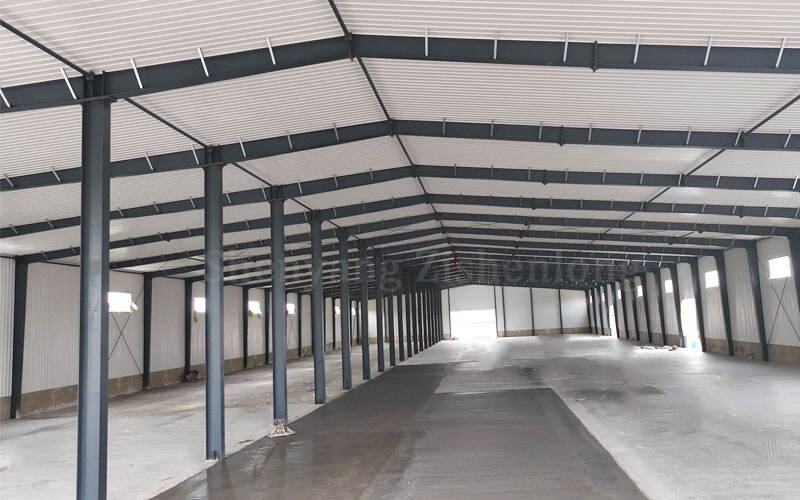Maximized Space Efficiency with Clear-Span Steel Design
How Clear-Span Steel Structures Eliminate Interior Columns for Uninterrupted Bulk Storage
Steel structures that clear the entire span create much more usable space since they don't need those annoying interior support columns. The result? Floor plans that stretch as far as 300 feet across without anything getting in the way. Warehouse operators report almost double the storage capacity when comparing these open designs to older buildings with their grid of columns everywhere. Engineers build special trusses and beams to hold up those massive roofs without needing extra supports in between. Forklifts, pallet jacks, and even automated storage systems can move around freely without hitting any obstacles. Some logistics research indicates these layouts cut down on material handling problems by about 35%, which makes a big difference in day-to-day operations.
Design Flexibility and Large-Span Capabilities for Optimal Space Utilization
The strength to weight ratio of steel gives architects plenty of flexibility when it comes to designing bay widths and eave heights. Standard racking systems typically work well within 40 to 60 foot spans, but some vertical carousel setups can actually stretch beyond 100 feet across. According to recent industry research from 2024, warehouses built with these long span steel structures managed to pack in about 22 percent more storage space compared to similar buildings made with concrete. And here's the kicker they still passed all the necessary fire safety checks and met earthquake resistance standards too.
Integrating High-Density Storage Systems in Column-Free Steel Warehouses
The absence of interior columns enables full deployment of advanced storage solutions:
- Push-back racking systems reaching 48-foot heights
- Automated cube storage for small-item inventory
- Cross-docking layouts with 360° accessibility
These configurations increase storage capacity by up to 150% while maintaining OSHA-compliant aisle widths.
Case Study: Logistics Company Boosts Storage Capacity by 40% With a Pre-Engineered Steel Warehouse
A logistics company based in Kansas City recently swapped out their old concrete warehouse for something much better - a modern steel building with those impressive 250 foot clear spans that make such a difference. This new space was designed specifically for semi automated narrow aisle racking systems, which allowed them to boost their storage capacity dramatically. They went from holding around 12 thousand pallets to nearly 17 thousand, basically adding an extra four thousand spots overnight. The management team also thought ahead about lighting solutions, strategically placing skylights throughout the facility that cut down on electricity bills quite a bit. Looking at their numbers post renovation, they noticed orders were being fulfilled almost 30% faster than before, which made all the investment worthwhile for sure.
Cost-Effectiveness and Long-Term Savings of Steel Warehouses
Reduced operational and maintenance costs due to durable steel construction
Galvanized steel resists corrosion, moisture, pests, and environmental wear, significantly reducing repair frequency. Compared to wood or masonry, steel structures require up to 40% less maintenance, leading to lower annual upkeep budgets and fewer service disruptions.
Longevity of steel structures minimizing repairs and downtime
Pre-engineered steel buildings maintain structural integrity for over 50 years with minimal intervention. Welded connections and protective coatings withstand daily operational stress far better than materials like concrete or timber, which degrade over time and demand recurring repairs. This durability minimizes downtime and extends asset life.
Lifecycle cost comparison: Steel vs. concrete warehouses
Although initial construction costs may be comparable, steel warehouses deliver 22–35% lower total ownership costs over 30 years. Key advantages include:
- 60% faster construction, cutting financing and labor expenses
- 30% lighter foundations, reducing site preparation costs
- 45% lower energy consumption due to superior insulation integration
- No long-term degradation costs, unlike concrete spalling or wood rot
This makes steel the more fiscally responsible choice for sustainable, long-term facility investment.
Rapid Construction and Scalability of Pre-Engineered Steel Buildings
Fast Installation Using Prefabricated Steel Components Cuts Project Timelines
Prefabricated steel components are precision-cut offsite and arrive ready for rapid assembly, reducing construction timelines by 30–50% compared to conventional methods. According to industry benchmarks, this acceleration helps businesses bring warehouses online faster, saving up to $18,000 per month in financing costs for mid-sized projects.
Scalable Design Supports Future Expansion and Evolving Inventory Needs
Steel’s modular design allows straightforward expansions—such as adding mezzanines or extending bays—without compromising structural performance. A 2023 logistics survey revealed that 78% of companies using modular steel construction doubled their storage capacity within five years without relocating.
Growing Trend: Modular Steel Warehouses in E-Commerce and Logistics
E-commerce operators deploy steel warehouses at a rate 45% higher than brick-and-mortar retailers, drawn by the need for flexible, scalable fulfillment centers. These structures support automation technologies like robotic pickers and vertical lift modules, which rely on uninterrupted clear spans only achievable through steel construction.
Adaptability for Dynamic Business Growth Without Structural Limitations
Steel frame designs accommodate reconfigurable interiors via movable partitions and adjustable racking. Unlike rigid concrete buildings, steel warehouses can be retrofitted 60% faster for new technologies—enabling smooth integration of AI-driven inventory systems and other digital upgrades.
Superior Strength and Load-Bearing Capacity for Heavy-Duty Storage
High Strength-to-Weight Ratio of Steel Enables Safe, Heavy-Load Storage
Steel’s advanced metallurgy supports loads exceeding 50 lbs/ft²—nearly triple the capacity of wood-frame buildings. Its high strength-to-weight ratio ensures safe, dense storage configurations while complying with ANSI MH16.1-2023 industrial rack safety standards.
Structural Optimization for Bulk Storage Systems Like Pallet Racking and Flow Racks
Pre-engineered steel frames allow precise customization of beam heights and column spacing to align with automated storage systems. Engineers reinforce critical zones for high-density racking while ensuring uniform load distribution across the structure.
Supporting Cantilever Racks for Long or Irregularly Shaped Materials
Steel’s flexibility supports cantilever systems spanning over 24 feet without intermediate supports. Durability assessments indicate these racks retain 98% load integrity after three decades, making them ideal for storing lumber, piping, and aerospace components.
Balancing High Load Capacity with Lightweight, Efficient Structural Footprint
Modern steel buildings use optimized truss designs with 18–22 gauge steel, reducing overall weight by 40% compared to traditional framing while enhancing load tolerance. This efficiency lowers foundation requirements and associated costs without sacrificing structural safety.
Integration of Industrial Storage Solutions Within Steel Warehouse Layouts
Dimensional accuracy in prefabricated steel components ensures seamless integration of vertical carousels, shuttle systems, and other automated equipment. This compatibility eliminates costly retrofitting and guarantees all systems operate within engineered load limits.
Customization Options for Doors, Insulation, and Interior Layouts
Strategic Door Placement and Sizing for Efficient Material Handling
Steel warehouses come with door setups that can be tailored to fit specific workflow needs. According to recent industry research from MMH in 2023, around 85% of people who handle materials consider where dock doors go as one of their main concerns when planning warehouse layouts. Many facilities opt for several 16 by 16 foot roll up doors when they need to do quick loading and unloading operations. Some bigger operations install these massive sliding doors that stretch up to 40 feet across just so they can get big equipment in and out without hassle. The newer automated doors that respond to motion actually cut down on energy waste by about 35% over regular doors, which makes them pretty attractive for companies looking to save money on utilities while keeping things running smoothly.
Thermal and Acoustic Insulation for Climate-Sensitive or Regulated Storage
Advanced composite sandwich panels with polyurethane (PU) foam cores achieve U-values below 0.25 W/m²K, providing stable temperature control (±2°C) for pharmaceuticals, electronics, and food storage. Acoustic-rated assemblies offer up to 42 dB noise reduction, supporting compliance in sensitive environments like lab supply chains.
Flexible Interior Configurations Supporting Automated or Dynamic Inventory Systems
Steel structures support bolt-on, rack-supported mezzanines rated for up to 250 psf, adaptable to evolving AS/RS needs. Operators can switch between narrow-aisle, drive-in, and shuttle racking systems without structural changes, with connection points designed for full reconfiguration within 72 hours.
Frequently Asked Questions
What are clear-span steel structures?
Clear-span steel structures are buildings designed without interior columns or supports, allowing for uninterrupted floor space.
Why are steel warehouses considered cost-effective?
Steel warehouses are cost-effective because they offer reduced operational and maintenance costs, along with faster construction times and scalability for future expansion.
How much storage can be gained using steel warehouses?
Steel warehouses, especially when using long-span designs, can increase storage capacity by up to 150% compared to traditional structures.
Table of Contents
-
Maximized Space Efficiency with Clear-Span Steel Design
- How Clear-Span Steel Structures Eliminate Interior Columns for Uninterrupted Bulk Storage
- Design Flexibility and Large-Span Capabilities for Optimal Space Utilization
- Integrating High-Density Storage Systems in Column-Free Steel Warehouses
- Case Study: Logistics Company Boosts Storage Capacity by 40% With a Pre-Engineered Steel Warehouse
- Cost-Effectiveness and Long-Term Savings of Steel Warehouses
- Rapid Construction and Scalability of Pre-Engineered Steel Buildings
-
Superior Strength and Load-Bearing Capacity for Heavy-Duty Storage
- High Strength-to-Weight Ratio of Steel Enables Safe, Heavy-Load Storage
- Structural Optimization for Bulk Storage Systems Like Pallet Racking and Flow Racks
- Supporting Cantilever Racks for Long or Irregularly Shaped Materials
- Balancing High Load Capacity with Lightweight, Efficient Structural Footprint
- Integration of Industrial Storage Solutions Within Steel Warehouse Layouts
- Customization Options for Doors, Insulation, and Interior Layouts
- Frequently Asked Questions

